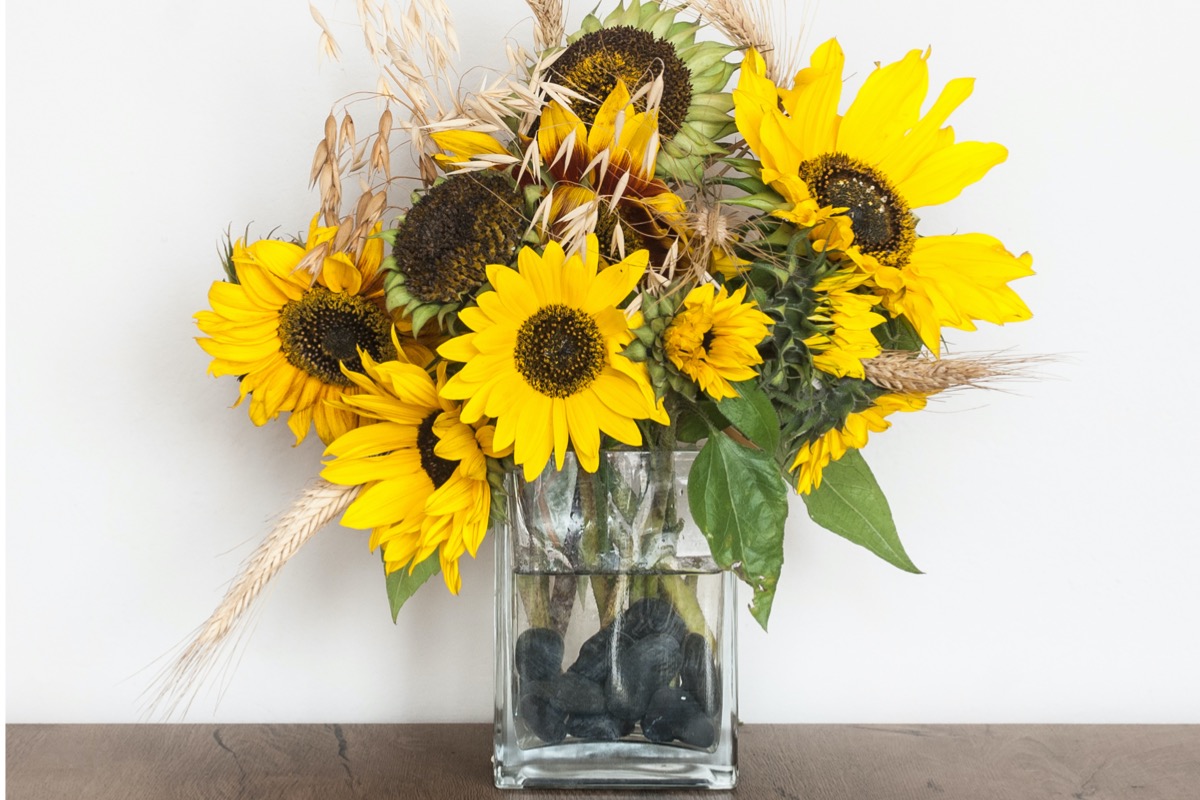We may earn revenue from the products available on this page and participate in affiliate programs. Learn More ›
Whether to commemorate special occasions or just brighten someone’s day, flowers enhance our lives. Beautiful blooms are mood boosters that bring good cheer to any setting.
By learning how to arrange flowers, you can save florist fees and express your creativity in a fun and fresh way. It’s easy enough to pick up a floral bouquet at the local supermarket, but true flower arranging involves more than knowing how to put flowers in a vase. With a little practice, you can learn how to make flower arrangements rivaling florist quality. All it takes is a good eye for color and balance and a few simple tools, such as a floral knife, thorn stripper, container, and—for more elaborate arrangements—perhaps some floral foam, floral picks, wire, and tape.
Tools & Materials
Bobvila.com may earn a commission from purchases made through these links.
BEFORE YOU BEGIN
Don’t get frustrated if your flower arrangements don’t turn out the first time like you envision. The end result will still feature beautiful flowers, so have fun with it as you follow along with these steps.
STEP 1: Select flowers, greenery, and a vessel.
Whether you have flowers delivered as part of a subscription service, buy a fresh bouquet from a florist or supermarket, or pick flowers from your garden, the flowers you select will determine the design and color scheme of your arrangement. It’s okay to go with one type of flower for a monochromatic bouquet, but you can also choose to incorporate different colors, shapes, sizes, and greenery.
Next, choose an appropriate vessel. For small flower arrangements, you can use small or short vases or containers, but you’ll need a larger, sturdier vase for large flowers. The type of vessel can dictate the arrangement’s style; iris vases are well suited to simple displays of spring beauties, for example.
RELATED: The 30 Best Gifts for Gardeners That They’ll Actually Use

STEP 2: Trim and hydrate all cuttings.
Trim the flower stems to length according to the size of your selected vessel, cutting them at an angle with a floral knife. Remove any thorns and all leaves that would be below the water line. Diagonally cutting stems helps them draw up water better, which will give them longer life in your arrangement. Place them in a “holding tank,” such as a large cup or another vase, so they stay hydrated while you design your arrangement—a container of warm water and floral preservative will suffice.
STEP 3: Prepare a floral preservative.
Floral preservative provides many benefits. In addition to providing food to keep flowers fresh for longer, the preservative can help prevent bacteria growth. Most florists send packets of floral preservative with bouquets and arrangements, but if you’re designing your own, you can buy them online. If you make a lot of flower arrangements, you can buy flower food and preservative in larger, more economical containers.
You can also make your own floral preservative using a variety of recipes. For better absorption by the flowers, add floral preservative to warm water.
STEP 4: Add stability to the vessel.
Most designated vases and flower vessels are constructed for stability when holding flowers, but flower lovers often choose alternative containers in which to create their designs. Tall or top-heavy blooms and branches might need a weighted container. A trick for additional stability involves arranging strips of floral tape in a grid pattern at the container’s opening to provide extra support and spacing for the flowers.
Floral frogs aren’t used often nowadays, but they work well for minimalist designs (like traditional Japanese Ikebana flower arrangement) and flowers with large stems, such as gladiola. Floral foam, when saturated and taped down, adds weight and stability to a vessel. It also makes angling and securing flowers a breeze. Some people use Styrofoam, but it doesn’t add much weight since it doesn’t absorb water.
Pebbles or glass gemstones can add weight to a container, help hold stems in place, and look attractive through clear containers.

STEP 5: Start with greenery and focal flowers.
Greenery provides a framework for your arrangement, so start by adding leafy stems. Palm fronds and fern leaves are the most common greenery used, but you can incorporate almost anything: ivy, eucalyptus, holly, and even greenery that isn’t green, such as dusty miller. Establish a crisscross pattern with foliage for greater flower support. Leatherleaf fern is typically used by florists for its sturdiness as much as its glossy leaves.
Next, insert the anchor (or focal) flowers. They might be the largest blooms of the bunch or the flowers you want to highlight. These focal flowers should define the architecture of the arrangement. Add them in odd numbers for best form and pattern.
STEP 6: Add in filler flowers and delicate blooms.
Filler flowers, or secondary flowers, are smaller blooms that fill in the space between the focal flowers. They might complement the color or shape of the focal flowers, but they can just as often reside within the same color family.
Filler flowers can add texture and color, fill in spaces, and help define the shape of the arrangement. Some, like delphinium and snapdragons, can add height. Others, such as feverfew daisies, add delicate wispiness. Holly, meanwhile, can introduce some holiday cheer.
If using only one filler flower (such as baby’s breath in a rose bouquet), it’s wise to add additional greenery.
RELATED: 15 Dish Garden Plants for Unique Arrangements

STEP 7: Keep the arrangement shipshape.
Whether you get your floral arrangement from a flower delivery service or make it yourself, keep it fresh for as long as possible by following a few simple steps.
Make sure flowers have enough water. Change the water and add new flower food every 2 to 3 days. Remove dead leaves and blooms. As an added hydration and protection measure (especially for flower arrangements with little to no water), thoroughly mist petals and leaves with FloraLife Clear Crowning Glory spray.
Don’t place the vase or arrangement in direct sun, and keep it away from heat drafts and heat-generating appliances. The flowers will last longer in cool temperatures. To keep them from dehydrating, place your arrangement away from open windows, fans, or cooling vents. And don’t place the container near fruit, which gives off ethylene gas as it ripens, as this gas can shorten the life of cut flowers.
Final Thoughts
While learning how to arrange flowers in a bouquet or creating more complex designs, you might enjoy it so much that you discover a new hobby or career. You’re likely to discover more about flowers and plants as your skills develop, making it possible for you to create increasingly elaborate and attractive arrangements.
Using the proper tools and following the above steps should produce pleasing results that last for days.
Related: How to Dry Hydrangeas for Stunning Tabletop Displays


